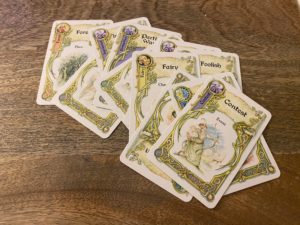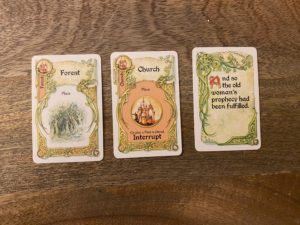Once Upon a Time is a multi-player storytelling game. This game is similar to the storytelling game my team is prototyping. Some things I was curious about are:
- How does theme help generate ideas for the players?
- How do players balance telling a cohesive story while trying to advance their own agenda? What aspects of the game create and balance this dynamic?
The elements on the cards are all fairytale-themed. This helps tremendously with idea generation, as players are familiar with the genre from childhood stories. The art on the cards are also consistent with the theme, which made it fun as players can use it as inspiration for their story.
Each player has a number of Story Cards as well as a unique Ending Card. Only one player is telling the story at a time as they try to use all of their cards as elements in the game. Other players may interrupt and take over the storytelling, following some rules for how they are allowed to interrupt. The player who wins is the one to use all their cards and finish the story with their ending.
Left to right: a Story Card, an Interrupt Story Card, and an Ending Card
The interruption of games is the biggest point of contention, as it is how a player can take over to try to win. Users may interrupt with Interrupt Cards, which allow them to interrupt if a certain type of story element is used by the storyteller. However, if players don’t have Interrupt Cards at their disposal, they can only interrupt when they have an overlap with the story and their Story Cards. This rule is quite subjective: the players decide how strong of an overlap their Story Card must have with the story element. When players try to take over the story with a weak connection, others can object. In this way, players hold each other accountable to the rules.

Storyteller: [deals a Princess card] The princess paced back and forth, looking for her lost book-
Interrupter: – of Potions! Which she needed to cast a spell. [deals a Spell card]
Other Players: You can’t do that! That’s not a connection! You have to have a Book or Almanac or Journal card or something…
During the critical play, I noticed that in the rounds where other players were relaxed about interruptions, the pace of play was fast, but the story would jump back and forth and the narrative was very difficult to follow. When the group was more strict about the use of Story Cards, the pace of play was slower as it required more thought, and there were more *arguments* on if a certain Story Card could be played or not, but the story was more compelling. The pace of play and story generation is dependent on the players’ adherence to rules and competitiveness. For our game, we may need to add some more mechanics to incentivize players to generate a cohesive story.
The one winner format makes the game competitive, and challenging, while the satisfaction of telling an interesting fairytale gives the game a fantasy aesthetic. The fun of the game was amplified by the energy of oral storytelling, so I am curious how different it would feel if it were an online format instead of a physical card game with oral storytelling.



